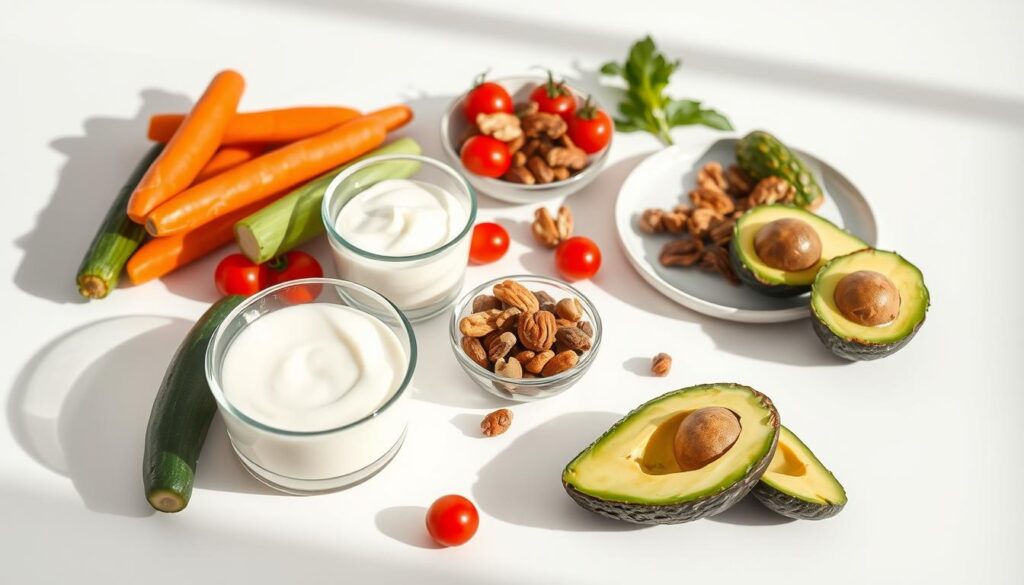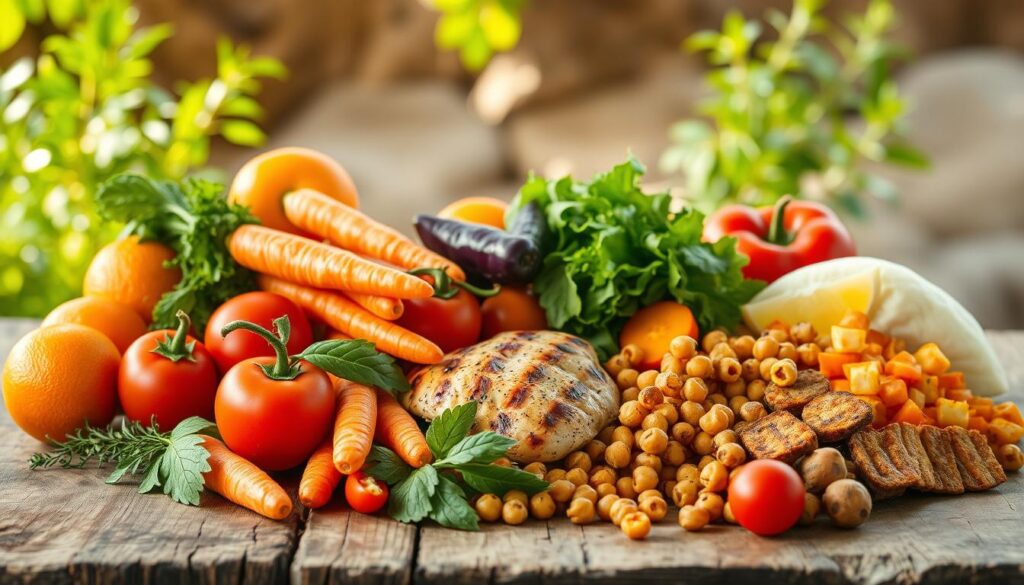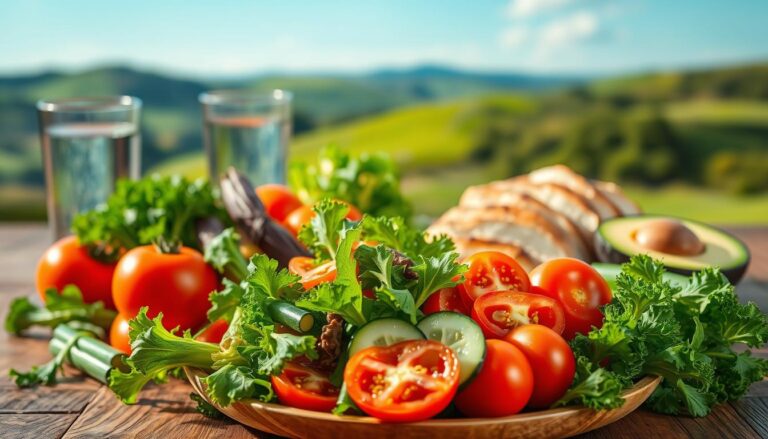Have you ever wondered why most healthy eating plans fail within weeks? While many people associate better health with strict rules or calorie counting, sustainable results come from smarter strategies. This guide reveals how small changes can create lasting improvements in your overall health without upending your lifestyle.
Modern nutrition science shows that successful diet adjustments rely on consistency, not perfection. Adults often consume more calories than needed while missing essential nutrients. Balancing energy intake with activity levels forms the foundation of effective nourishment.
Our approach focuses on realistic modifications that fit busy schedules. You’ll learn how to prioritize nutrient-dense foods, understand portion control, and make informed choices. These methods require minimal meal prep time while delivering maximum benefits.
Key Takeaways
- Gradual adjustments prove more sustainable than drastic overhauls
- Balanced nutrition supports energy needs and metabolic functions
- Practical strategies work for time-constrained individuals
- Evidence-based methods ensure reliable results
- Consistent application improves digestion and weight management
- Food quality matters more than complex calculations
Understanding the Basics of a Healthy Diet
What separates effective nourishment from short-lived trends? The answer lies in mastering two core principles: energy balance and food quality. These foundations determine how your body converts meals into lasting vitality.

Balancing Calories and Energy
Your body operates like a precision engine. It needs the right fuel quantity to match daily activities. Most adults require 2,000-2,500 calories daily, but this varies by age and movement levels.
Consuming extra calories creates fat storage. Too few leads to fatigue. Use this table to gauge needs:
| Activity Level | Men (Calories) | Women (Calories) |
|---|---|---|
| Sedentary | 2,200-2,400 | 1,800-2,000 |
| Moderate | 2,600-2,800 | 2,100-2,300 |
| Active | 3,000+ | 2,400+ |
Selecting Nutrient-Dense Foods
Not all calories deliver equal nutrition. A 300-calorie doughnut lacks the vitamins in salmon and quinoa. Prioritize whole foods that pack nutrients per bite.
Colorful produce, lean proteins, and whole grains offer sustained energy. Processed snacks often contain empty calories. Make sure your plate includes:
- Leafy greens for magnesium
- Berries for antioxidants
- Nuts for healthy fats
8 Simple Ways to Start Eating Healthy Today
Smart food choices create energy that lasts. Focus on two pillars: carbohydrates that sustain and proteins that repair. These elements work together to stabilize blood sugar and keep hunger at bay.
High-Fiber Carbohydrates for Lasting Fullness
Whole grains outshine refined options. Brown rice and quinoa offer 3-5x more fiber than white varieties. This slows digestion, helping you feel satisfied longer after meals.
Starchy foods should fill one-third of your plate. Keep potato skins intact – they add 2g of fiber per serving. Pair these with vegetables for balanced nutrition.
Lean Protein and Fish for Optimal Health
Animal and plant proteins build muscle and boost immunity. Grill chicken instead of frying. Canned tuna makes quick protein-packed lunches.
Oily fish delivers essential omega-3s. Try salmon patties or sardine toast twice weekly. These fats support brain function and reduce inflammation better than supplements.
Combine these strategies at meal times. A baked sweet potato with grilled mackerel covers both carb and protein needs in 25 minutes. This approach saves time while maximizing nutrients per bite.
Smart Swaps for Reducing Sugar and Salt
Small changes in your pantry choices can lead to big health wins. Many common foods and drinks contain hidden sweeteners and sodium that strain your body over time. Strategic replacements help maintain flavor while protecting your heart and energy levels.

Reducing Free Sugars in Your Diet
Added sweeteners hide in unexpected places. A single soda can contain 39g of sugar – nearly double the daily limit. Check labels for these common culprits:
| High-Sugar Item | Better Choice | Savings Per Serving |
|---|---|---|
| Flavored yogurt (19g) | Greek yogurt + berries (8g) | 11g sugar |
| Granola bar (12g) | Almonds + dark chocolate (5g) | 7g sugar |
| BBQ sauce (13g) | Spice rub + lime juice (0g) | 13g sugar |
Choose unsweetened versions of sauces and snacks. Infuse water with citrus or mint instead of juice boxes. Your taste buds adapt within 3 weeks, making natural sweetness more satisfying.
Lowering Unhealthy Fats with Better Choices
Not all fat deserves a bad reputation. Swap processed meats for grilled fish or avocado slices in sandwiches. Use this guide for smarter ingredients:
- Butter → Olive oil (reduces saturated fat by 50%)
- Chips → Roasted chickpeas (adds 5g fiber)
- Creamy dressing → Greek yogurt dip (cuts 80 calories)
For salt reduction, rinse canned beans and choose no-salt-added nuts. Season dishes with garlic powder or lemon zest instead of shakers. These changes lower blood pressure without sacrificing flavor.
Boosting Fruit, Vegetable & Protein Intake
Did you know your plate’s color variety directly impacts nutrient diversity? Vibrant meals packed with fruits and vegetables deliver essential compounds that processed foods can’t match. Pairing these with quality protein creates meals that sustain energy and curb cravings naturally.

Daily Portion Targets Made Simple
Meeting the recommended five daily portions becomes effortless with proper measurement. One serving equals:
| Food Type | Serving Size | Examples |
|---|---|---|
| Fresh/Frozen | 80g | 1 medium apple or 8 broccoli florets |
| Dried Fruit | 30g | 1 tablespoon raisins or 4 dried apricots |
| Juices/Smoothies | 150ml | Small glass of orange juice |
Frozen spinach retains 100% of its nutrients, while canned beans offer quick vegetable boosts. Add berries to oatmeal or blend kale into morning shakes for effortless intake.
Protein enhances these benefits by slowing digestion. A palm-sized chicken breast or cup of lentils at meals helps maintain muscle mass. Studies show adequate protein intake can increase daily calorie burn by 80-100 calories through thermogenesis.
Combine both strategies for maximum effect: top sweet potato toast with smoked salmon, or mix chickpeas into stir-fried vegetables. This way of eating supports immunity while keeping hunger signals steady throughout the day.
Meal Planning, Portion Control, and Mindful Eating
What if your dishware could help manage portions effortlessly? Combining strategic planning with awareness transforms how you fuel your body. These methods work together to support weight goals while maintaining satisfaction.
Portion Control Strategies with Smaller Plates
Research reveals a surprising truth: plate size impacts consumption. A 2017 study found those using smaller dishes ate fewer calories yet felt equally satisfied. This visual trick helps people naturally reduce portions without tracking every bite.
Try these tips: Use salad plates for main meals and narrow glasses for drinks. This approach supports gradual weight loss by aligning portions with actual energy needs. Make sure colorful vegetables fill half your plate for automatic balance.
Mindful Eating Practices to Savor Every Bite
Speed matters more than you think. Fast eaters consume 20% more calories on average compared to slower counterparts. Chew thoroughly and pause between bites. This gives your brain time to register fullness signals.
Turn off screens during meals to focus on flavors and textures. Studies show mindful eating improves digestion and helps maintain a healthy weight. These habits transform nourishment from routine to ritual.





